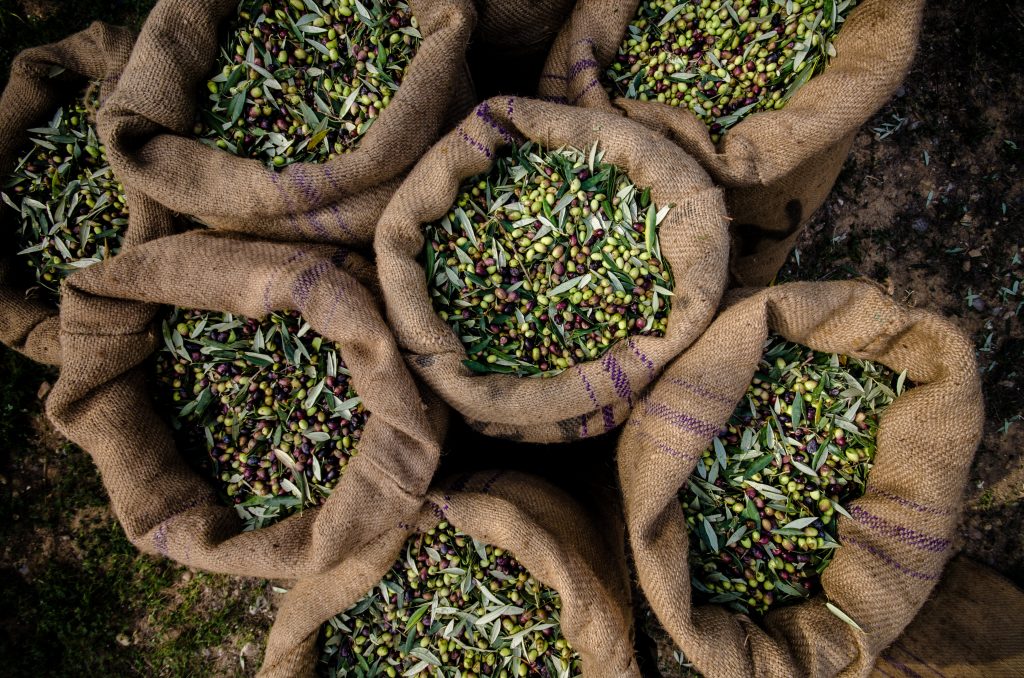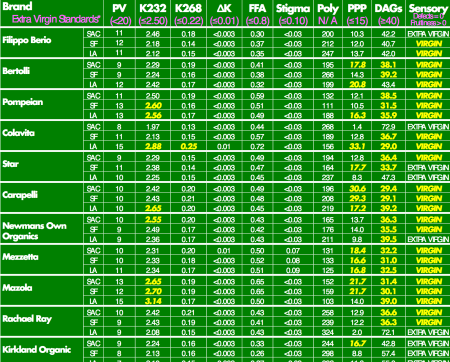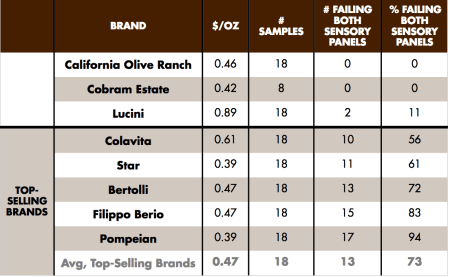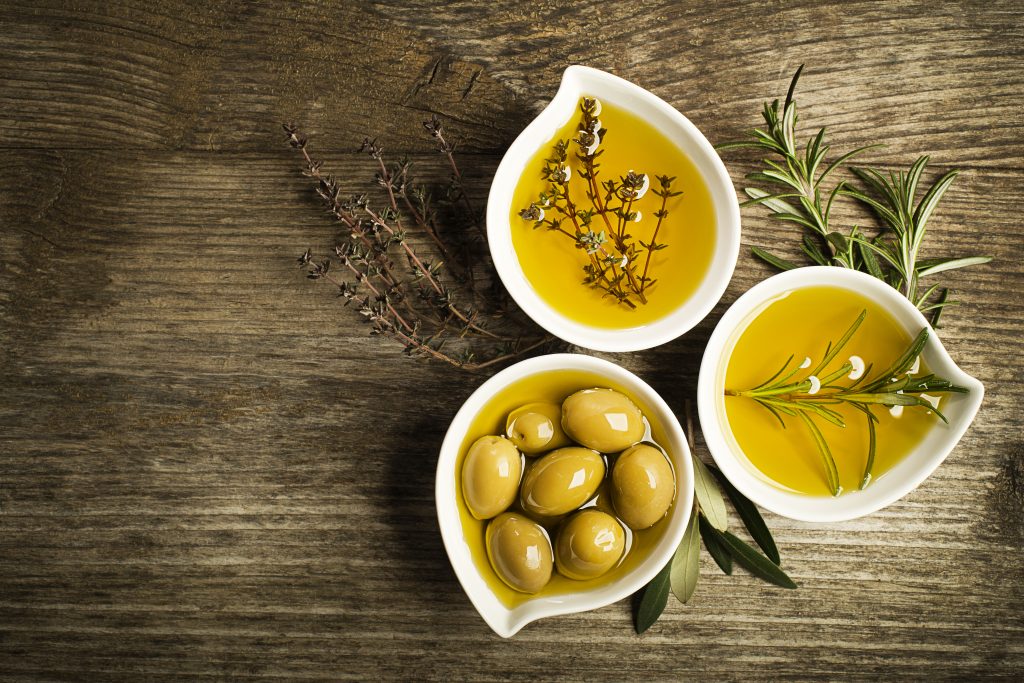In Julia Child’s book, “Mastering the Art of French Cooking”, she provides a list of ingredients that would be beneficial to have in one’s kitchen when cooking french food – olive oil not being one of them. Why? “Olive oil, which dominates Mediterranean cooking, has too much character for the subtle flavors of a delicate dish.”(page 19, Child, J., 1961). Have you ever tasted or smelt the overpowering, floral and robustness of true extra virgin olive oil. An oil that is the dressing of salad or a sauce for a steak and not simply an ingredient in a vinaigrette or grave. If not, don’t get saddened that you have been deceived, big business is in it for itself, not your health.
Lampante in Italian means ‘lamp oil’ and it is used to describe olive oil that is produced from olives that have fallen to the ground or from olives that are overripe, as well as oil that has gone rancid due to being stored for too long resulting in it being treated and refined. The legal definition of extra virgin olive oil (EVOO) according to International Olive Council is “virgin olive oil which has a free acidity, expressed as oleic acid, of not more than 0.8 grams per 100 grams and the other characteristics of which correspond to those fixed for this category in the IOC standard.” According to Larry Olmsted “real olive oil is nothing but the juice extracted from high quality, fresh olives, otherwise unprocessed and with its flavor and health benefits wholly intact” (page 88, 2016). ‘Extra virgin’ is the highest grade of olive oil, however, most times the label does not meet the standard.

“It says what every olive oil says: 100 percent Italian, cold-pressed, stone ground, extra virgin…”
He shook his head, as if unable to believe his eyes. “Extra virgin? What’s this oil got to do with virginity? This is a whore.”Tom Mueller, Extra Virginity: The Sublime and Scandalous World of olive oil
Where seed oils are extracted through the use of solvents, high heats and harsh pressure in refineries the best of olive oil is pressed using either a hydraulic press or a centrifuge (a rapidly spinning machine that applies pressure to its content in an effort to separate different densities – such as water and oil from an olive) resulting in more ‘freshly pressed juice’ than ‘oil’. Real extra virgin olive oil is pressed from olives that are on the verge of turning from green to black – known as the veraison period. To become the most tasteful oil, the olive should be picked by hand and milled within a few hours of harvest. This ensures a decrease in oxidation as well as reducing enzyme reactions, which otherwise would result in an ill-tasting and unpleasantly pungent oil (Mueller, T., 2011) (Mueller, T., 2007).
Some olive oil producers to bring up their overall yield will harvest olives that have ripened fully and are black or simply wait till they have fallen off the olive tree, at which point they are often rotten. The riper the fruit the more juice is produced, however, it comes at the cost of flavor and nutrient density. Waiting for the olive to fall off the tree results in one of the poorest quality of oils – one that is most definitely lampante. As soon as the olive is picked – or in this case as soon as it falls from the tree, it begins to deteriorate. The best olive oils are made from olives that are pressed/milled within hours of harvest (ultimately in a 12-hour window from the point of harvest – some connoisseurs will insist the window is that of as little as an hour and no more than four). Waiting for 24 hours or more and fruit is essentially ruined and thus so will the oil be (Olmstead, L., 2016).
Ways That Olive Oil can be Lampante
- It can be diluted with less expensive oils such as seed oils, soybean, sunflower, hazelnut. Sometimes there might not even be any olive oil added it may simply be sunflower oil with chlorophyll added to it.
Example: “toxic oil syndrome” of Spain, 1981.
- Fake olive oil sold – which was truly refined rapeseed oil, which had been denatured with aniline (a toxic substance that is used in the manufacturing of plastic)
- 20,000 people were affected. 300 died. A high percentage of survivors developed chronic diseases; mainly neurological, scleroderma.
Although it is rather unlikely that one would come upon such a toxic substance in an olive oil bottle is it is likely that an allergic reaction could occur as a result of contamination (Olmsted, 2016) (Gelpí, E., et al, 2002).
2. This is the most common – extra virgin olive oil diluted with lower grades of olive oil. The less desirable olive oil used is usually heavily refined with chemicals, stale and has most of its beneficial nutrients removed as a result of the processing done to it.
How the University of California Davis’s Olive Oil Center Tests for Fake Oil and What they Found
In 2010 the University of California Davis’s Olive Oil Center conducted tests to see if imported and domestic ‘extra virgin’ olive oil was truly an extra virgin. Pairing up with a laboratory in Australia they looked at fourteen imported and five California brands of extra virgin olive oil (EVOO), using not only the IOC and USDA standards (as they do not always pick up on defective olive oils) of grading olive oil but also the “German/Australian 1, 2-diacylglycerol (DAGs) and pyropheophytins (PPP) standards. An elevated level of DAGs indicates that the samples were oxidized, of poor quality, and/or adulterated with cheaper refined oils, while the elevated level of PPP indicates that the samples were oxidized and/or adulterated with cheaper refined oils” (page 2, Frankel, E.N., et al, 2010). By using all four evaluation standards they were better able to weed out fake oils, of which 86% of the oils they had looked into were not “extra virgin” but a much lower grade of virgin olive oil. Below is a chart depicting 11 of the olive oil brands that the study had looked into. The highlighted ‘virgin‘ expresses fake oils that were falsely labeled.

The following year UC Davis’s Olive Oil Center conducted similar research by looking once again into the quality of extra virgin olive oils sold in California, both imported and domestic brands. Both studies combined ended up looking into 186 samples of extra virgin olive oil (EVOO). Though they looked at fewer brands in the 2011 study, the brands did remain top sellers in the United States and instead the researchers choose a greater selection of samples from each brand. Yet again many bottles were labeled inappropriately and several failed to meet standards set by the USDA, IOC and Australia and Germany (Fankel, E.N., et al, 2011).
[inline-ad]The charts below display the study’s findings. The University of California Davis’s Olive Oil Center concluded that although California did provide some good olive oils most of the top-selling brands in the United States (which are similarly the top-selling brands in Canada) failed most sensory panel testing. Specifically; on average 73% of international samples failed IOC panel testing (ranging between brands from 94% to 56%) and 70% failed the German and Australian chemical testing panel. They may have been an oil, such as hazelnut, perhaps some of them even contained oil from olives. Regardless, the oils they contained were not the “extra virgin” that they advertised and claimed to be (Ibid).


The testing that UC Davis conducted indicated that fake olive oils failed for the following reasons; “(a) oxidation by exposure to elevated temperatures, light, and/or aging; (b) adulteration with cheaper refined olive oil; and (c) poor quality oil made from damaged and overripe olives, processing flaws, and/or improper oil storage (page 2, Frankel, E. N. et al., 2011).” Many of the failed oils displayed two if not all of the prior points.
Has the Olive Oil Industry Improved?
Has much changed? Big businesses, like Bertolli, now display on their website health benefits and where their oils came from (Bertolli’s website for the ‘Truth about Bertolli Olive Oil’ was not working when I tried it out Monday, April 24, 2017). However, not much has changed in those six years since the UC Davis report came out. Italy is still the largest supplier of exported extra virgin olive oil and yet they don’t produce enough to supply the country itself. Most olive oil that is exported from Italy is rancid olive oil from Italy mixed with extra virgin olive oil from Spain. Because there is still some good quality oil in the bottle it is easier for the lampante oil to escape detection (Olmsted, 2016).
So where does one come upon good quality extra virgin olive oil with all the health benefits? Well, if it’s made locally and you can talk to a farmer that is your best bet. Otherwise, below you will find some guidelines to direct you when purchasing a bottle of liquid gold (with a touch of green).
What can be done about fake olive oil? And how to tell what is REAL!
In 2004 the FDA authorized the labeling of health claims on olive oil (such as; aids in the prevention of cardiovascular disease and cancer), however, just as with drugs, not every oil is tested nor its quality rechecked. This means that lampante oil, fake olive oil will hold the same claims as real extra virgin olive oil. The important question is how does one distinguish between the good and the bad (and the really ugly).
The best way to tell is by taste. If you feel that olive sting (that intense burn) at the back of your throat you have some good olive oil on your hands. Whenever possible always taste the olive oil before you purchase it.
Choose from a reputable source!
McEvoy Ranch produces high quality extra virgin olive oil in California. You can purchase their oil online and have it shipped. Their 100% organic olive oil, is hand-picked and harvested in small batches. California olive oil (EVOO).
Boulder Bendor Cobram Estate established in 1998, their groves in Murray River Valley, Australia hold 2.4 million olive trees, with approximately 14 distinct varieties. Their limited edition extra virgin olive oil is milled within four hours of picking. Although the other oils they produce may take a bit longer they still uphold the same quality and standards throughout all their products.
Oro Bailen, a Spanish olive oil company that in 2005 became producers, packers and marketers of extra virgin olive oil. The olives they harvest and mill are ones they pick from their two family farms.
Fresh-Pressed Olive Oil Club founded by T.J. Robinson (the olive oil hunter), the olive oils provided are all extra virgin, primarily from small batches that T.J. Robinson inspects himself (he is world-renowned for his knowledge and appreciation of olive oil). There are two options to select from, both providing “quarterly shipments of three oils – mild, moderate, and strong – always new and fresh, alternating seasonally form the Northern and Southern Hemispheres” (page 107-108, Olmsted, L., 2016).
Olive oil dispensary; they may not be incredibly common but if you stumble upon one, jump in. They store their olive oil in metal airtight vats and dispense them into smaller glass containers or tins, which is preferable as olive oil should be used up quickly and not left to oxidize on a shelf. The best part is that you can often try the oil before you buy it. Try to taste the olive sting, if it’s not there….move along.
Read the Label
What is one supposed to look for on an olive oil label? How can one tell what is false printing and what is accurate? Here are some points to look for …
- The more information provided on the label the better, as producers who care for their product and quality will want you to know the same.
- Olive oil does not get better with age! Check the date that it was harvested on, do not look at the ‘best before’ or ‘bottled on’ dates, as the olive oil may have been sitting in a vat for a year before it was packed and shipped off to you.
Although ‘extra virgin” can no longer be taken as an absolute, not seeing it printed on a label is a strong indicator to stay far away.
Larry Olmsted recommends that no one buy anything that is labeled with; virgin, pure, light, extra light, olive oil blend or Mediterranean blend.
“First pressed”, “cold-pressed” and “first cold-pressed” – are rather meaningless on a label. As most oils are centrifuged there is really no first or second pressing nor heat added. More importantly, these terms are unregulated. Extra virgin olive oil by definition cannot come from a second pressing, therefore there is no need to press the fact.
When buying extra virgin olive oil from California make sure that it has this label on it “COOC certified extra virgin“.
There are global organizations that provide a seal of approval for real extra virgin olive oil. An organization of Italian olive growers known as the Extra Virgin Alliance (EVA), they go beyond IOC testing, ensuring that their products are 100% extra virgin. Other organization labels to look for include UNAROL and 100% Qualita Italiana
Do not rely on USDA Organic certification from oils coming from the United States of America or elsewhere.

Best Countries to buy Olive Oil From
- Chile or Australia – it’s a toss-up between the two. Both countries hold very high standards for olive oil production. Neither country participates in carrying over old olive oil to compensate for the lack of new olive oil production. Purchase these oils only during the fall and winter.
- United States – Though they may not have the latest testing methods that Australia imparts on their oils, you can rest assured that you are most likely purchasing real olive oil. Purchase oil from here during the spring and summer.
- Europe – If you happen to be vacationing in Europe, or perhaps live there you can still come across amazing extra virgin olive oil. Don’t let the fraudulent oils detain you from finding a hidden gem. Spain and Greece and good places to start with. Purchase these oils only during the spring and summer.
How to Store Olive Oil at Home & How Long to Keep it For
Olive oil is, in essence, a freshly squeezed fruit juice. It is perishable and thus cannot be kept and should not be kept for a long time. For if you do, that extra virgin olive oil will go rancid. Therefore, buying a large quantity is not a good idea.
Olive oil detests heat and light. Both aid in its denaturing. Make sure to store it in a cool dark place. Also, make sure that when you purchase it that the lovely bottle you are about to take home has not been displayed right by the window of a shop (if the glass is clear, then the situation is even worse).
Tins are preferred to opaque glass. Though overall, make sure the container is not made of plastic and/or translucent in any way.
RULE OF THUMB – buy enough olive oil that will serve you for no longer than six weeks (give or take a few days). Any longer and there is a high probability that you have rancid oil on your hands. Oxygen is an oil killer. Every time you open and use the olive oil you allow oxygen into the bottle.
How long can olive oil last on a shelf at home? If unopened, stored in a dark and cool place and preferably in a tin (if not a dark opaque glass) olive oil can last for between six to twelve months.
References
Beauchamp, Gary K. et al. “Phytochemistry: Ibuprofen-Like Activity In Extra-Virgin Olive Oil”. Nature 437.7055 (2005): 45-46.
Davidson, Alan. The Oxford Companion To Food. 1st ed. Oxford [u.a.]: Oxford Univ. Press, 2014.
“Designations And Definitions Of Olive Oils – International Olive Council”. Internationaloliveoil.org. N.p., 2017. Web. 11 Apr. 2017.
Erasmus, Udo. Fats That Heal Fats That Kill. 1st ed. Burnaby, BC: Alive Books, 1993.
Frankel, E.N., Mailer, R. J., Shoemaker C.F., Wang, S.C., & Flynn. J.D. (2010). Tests indicate that imported “Extra Virgin” Olive Oil often fails International and USDA Standards. University of California Davis; California.
Frankel, E. N.; Mailer, R. J.; Wang, S. C.; Shoemaker, C. F.; Guinard, J.-X.; Flynn, J. D.; Sturzenberger, N. D. (2011). Report. Evaluation of Extra Virgin Olive Oil Sold in California. University of California Davis; California.
Gelpí, Emilio et al. “The Spanish Toxic Oil Syndrome 20 Years After Its Onset: A Multidisciplinary Review Of Scientific Knowledge”. Environmental Health Perspectives 110.5 (2002): 457-464.
Holford, Patrick. The Optimum Nutrition Bible. 1st ed. London: Piatkus, 2009.
Janick, J. (2005). The Origin of Fruit, Fruit Growing, and Fruit Breeding. Plant Breeding Rev. 25:255-320
“Monte Testaccio: The 2,000-Year-Old Garbage Dump In Rome”. Amusingplanet.com. N.p., 2017. Web. 12 Apr. 2017.
Mueller, T. (2007, August). Slippery Business, The Trade in Adulterated Olive Oil. The New Yorker. Online Available: www.newyorker.com/magazine/2007/08/13/slippery-business
Mueller, T. Extra Virginity. 1st ed. New York: Atlantic Books Ltd, 2011.
“Oleic Acid”. SpectraCell Laboratories. N.p., 2017. Web. 11 Apr. 2017.
Olmsted, Larry. (2016). REAL FOOD/FAKE FOOD why you don’t know what you’re eating and what you can do about it. 1st ed. North Carolina: ALGONQUIN OF CHAPEL HILL.
Parkinson, Lisa, and Russell Keast. “Oleocanthal, A Phenolic Derived From Virgin Olive Oil: A Review Of The Beneficial Effects On Inflammatory Disease”. International Journal of Molecular Sciences 15.7 (2014): 12323-12334.
Schatzker, Mark. The Dorito Effect: The Surprising New Truth About Food And Flavor.1st ed. New York, US: Simon & Schuster (us & Uk), 2016.
Amanda Filipowicz is a certified nutritional practitioner (CNP) with a bachelor in environmental studies (BES) from York University. She also has certification in clinical detoxification, prenatal and postnatal care as well as nutrition for mental health. She has been working as a nutritionist since 2013 and is a lifelong proponent of eating healthy.

